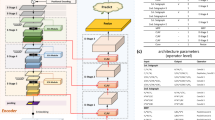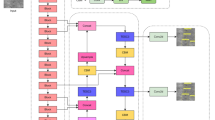Abstract
To address the limitations of traditional defect detection methods for power transmission lines, this paper proposes an intelligent defect recognition method based on self-adjusting Transformer. Firstly, a deterministic networking with a large receptive field is used to extract features from the defect images obtained during power transmission line inspections. Subsequently, a DQN is employed to select important regions containing foreground information. Secondly, a bilinear attention mechanism is utilized to project the background region feature vectors, compressing their contribution in the fused feature vectors of the foreground and background regions. Furthermore, the fused feature vectors are input into a Transformer network based on adaptive encoding layers, enabling better focus on the target region. Position-scale constraints are added to the decoding layers of the Transformer to enhance the attention’s emphasis on position-scale information, thereby accelerating the convergence speed of the Transformer. Finally, gate units are introduced in each decoding layer to adaptively adjust the structure of the Transformer decoding layers to accommodate the feature extraction requirements of different inputs. Experimental studies on aerial images of power transmission line defects were conducted, and the proposed method achieved an average detection accuracy of 89.9\(\%\). Compared with other commonly used algorithms, it demonstrated superior detection accuracy and generalization ability.
















Similar content being viewed by others
Data availibility
The datasets generated during and/or analyzed during the current study are available from the corresponding author on reasonable request.
References
Luo P, Wang B, Ma H, Ma F, Wang H, Zhu D (2021) Defect recognition method with low false negative rate based on combined target detection framework. High Volt Eng 47(02):454–464
Antwi-Bekoe E, Liu G, Ainam JP, Sun G, Xie X (2022) A deep learning approach for insulator instance segmentation and defect detection. Neur Comput Appl 34(9):7253–7269
Zhu S, Gao Q, Lu Y, Sun D (2018) Identification and location of insulator string based on frequency-tuned. Trans China Electrotech Soc 33(23):5573–5580
Mishra DP, Ray P (2018) Fault detection, location and classification of a transmission line. Neur Comput Appl 30:1377–1424
Li B et al (2022) Multi-target detection in substation scence based on attention mechanism and feature balance. Power Syst Tech 46(06):2122–2132
Mohd Amiruddin AAA, Zabiri H, Taqvi SAA, Tufa LD (2020) Neural network applications in fault diagnosis and detection: an overview of implementations in engineering-related systems. Neur Comput Appl 32:447–472
Dosovitskiy A, Beyer L, Kolesnikov A, et al (2020) An image is worth 16x16 words: Transformers for image recognition at scale. arXiv preprint arXiv:2010.11929
Carion N et al (2020) End-to-end object detection with Transformers. In: Proceedings of the European Conference on Computer Vision, pp 213-229
Mathe S, Pirinen A, Sminchisescu C (2016) Reinforcement learning for visual object detection. In: Proceedings of the IEEE conference on computer vision and pattern recognition, pp 2894-2902
Pirinen A, Sminchisescu C (2018) Deep reinforcement learning of region proposal networks for object detection. In: proceedings of the IEEE conference on computer vision and pattern recognition, pp 6945-6954
Alkali AH, Saatchi R, Elphick H, Burke D (2017) Thermal image processing for real-time non-contact respiration rate monitoring. IET Circ Dev Syst 11(2):142–148
Abeed MA, Biswas AK, Al-Rashid MM, Atulasimha J, Bandyopadhyay S (2017) Image processing with dipole-coupled nanomagnets: noise suppression and edge enhancement detection. IEEE Trans Elec Dev 64(5):2417–2424
Li W, Zhang Q, Wang D, Sun W, Li Q (2022) Stochastic configuration networks for self-blast state recognition of glass insulators with adaptive depth and multi-scale representation. Infor Sci 604:61–79
Kumar A, Kumar R (2018) Adaptive artificial intelligence for automatic identification of defect in the angular contact bearing. Neur Comput Appl 29(8):277–287
Peng S, Ding L, Li W, Sun W, Li Q (2022) Research on intelligent recognition method for self-blast state of glass insulator based on mixed data augmentation. High Volt 8:668–681
Zhang Q, Li W, Li H, Wang J (2020) Self-blast state detection of glass insulators based on stochastic configuration networks and a feedback transfer learning mechanism. Infor Sci 522:259–274
Li W, Tao H, Li H, Chen K, Wang J (2019) Greengage grading using stochastic configuration networks and a semi-supervised feedback mechanism. Infor Sci 488:1–12
Li W, Deng Y, Ding M, Wang D, Sun W, Li Q (2022) Industrial data classification using stochastic configuration networks with self-attention learning features. Neur Comput Appl 34:22047–22069
Tan S, Shen Z (2017) Hybrid problem-based learning in digital image processing: a case study. IEEE Trans Educ 61(2):127–135
Yang L, Fan J, Song S, Liu Y (2022) A light defect detection algorithm of power insulators from aerial images for power inspection. Neur Comput Appl 34(20):17951–17961
Zhang Y, Huang X, Jia JY et al (2019) A recognition technology of transmission lines conductor break and surface damage based on aerial image. IEEE Access 7(01):59022–59036
Chen JC, Yu YC, Chen Z, Han W (2021) An improved method for defect identification of transmission lines based on YOLOv3. Southern Power Syst Technol 15(1):114–120
Li R, Zhang Y, Zhai D, Xu D (2021) Pin defect detection of transmission line based on improved SSD. High Volt Eng 47(11):3795–3802
Dosovitskiy A, Beyer L, Kolesnikov A, et al (2020) An image is worth 16x16 words: Transformers for image recognition at scale. International Conference on Learning Representations
Touvron H, Cord M, Douze M, et al (2021) Training data efficient image Transformers & distillation through attention. International Conference on Machine Learning, pp 10347-10357
Liu Z, Lin Y, Cao Y, Hu H, Wei Y, Zhang Z, et al (2021) Swin Transformer: Hierarchical vision Transformer using shifted windows. Proceedings of the IEEE/CVF International Conference on Computer Vision, pp 10012-10022
Wang W, Xie E, Li X, et al (2021) Pyramid Vision Transformer: A versatile backbone for dense prediction without convolutions. Proceedings of the IEEE/CVF International Conference on Computer Vision, pp 568-578
Wang W, Xie E, Li X et al (2022) Improved baselines with pyramid vision transformer. Comput Vis Media 8(03):415–424
Heo B, Yun S, Han D, Chun S, et al (2021) Rethinking spatial dimensions of vision Transformers. Proceedings of the IEEE/CVF International Conference on Computer Vision, pp 11936-11945
Wu H, Xiao B, Codella N, et al (2021) Introducing convolutions to vision Transformers. Proceedings of the IEEE/CVF International Conference on Computer Vision, pp 22-31
Mathe S, Pirinen A, Sminchisescu C (2016) Reinforcement Learning for Visual Object Detection. 2016 IEEE Conference on Computer Vision and Pattern Recognition (CVPR), pp 2894-2902
Pirinen A, Sminchisescu C (2018) Deep Reinforcement Learning of Region Proposal Networks for Object Detection. 2018 IEEE/CVF Conference on Computer Vision and Pattern Recognition
Uzkent B, Yeh C, Ermon S (2020) Efficient Object Detection in Large Images Using Deep Reinforcement Learning. IEEE Winter Conference on Applications of Computer Vision
Al-Geelani NA, Piah MAM, Shaddad RQ (2012) Characterization of acoustic signals due to surface discharges on H.V. glass insulators using wavelet radial basis function neural networks. Appl Soft Comput 12(4):1239–1246
Lan Q, Pan Y, Fyshe A, White M (2020) Maxmin q-learning: controlling the estimation bias of q-learning. arXiv preprint arXiv:2002.06487
Ge S, Gao Z, Zhang B, Li P (2019) Kernelized bilinear CNN models for fine-grained visual recognition. Acta Elec Sin 47(10):2134–2141
Zhao M, Zhong S, Fu X, Tang B, Pecht M (2019) Deep residual shrinkage networks for fault diagnosis. IEEE Trans Ind Inform 16(7):4681–4690
Li Z, Peng C, Yu G, Zhang X, Deng Y, Sun J (2018) Detnet: design backbone for object detection. In: Proceedings of the European conference on computer vision (ECCV), pp 334-350
Yan D, Chen S, Peng G, Tan Y, Zhang Y, Wu K (2020) Live working manipulator control technology based on hierarchical deep reinforcement learning. High Volt Eng 0(2):459-471
Lin TY, RoyChowdhury A, Maji S (2015) Bilinear CNN models for fine-grained visual recognition. In Proceedings of the IEEE international conference on computer vision, pp 1449-1457
Sun Z, Cao S, Yang Y, Kitani KM (2021) Rethinking transformer-based set prediction for object detection. In Proceedings of the IEEE/CVF international conference on computer vision, pp 3611-3620
Li S, Roshan S (2019) The associations between working memory and the effects of four different types of written corrective feedback. J Second Lang Writ 45:1–15
Hochreiter S, Schmidhuber J (1997) Long short-term memory. Neur Comput 9(8):1735–1780
Williams RJ (1992) Simple statistical gradient-following algorithms for connectionist reinforcement learning. Mach Learn 8(3):229–256
Ren S, He K, Girshick R, Sun J (2017) Faster R-CNN: towards real-time object detection with region proposal networks. IEEE Trans Pattern Anal Mach Intell 39(6):1137–49
Jocher G, Stoken A, Borovec J, Chaurasia A, Changyu L (2020) ultralytics/yolov5. GithubRepository, YOLOv5
Zhou X, Koltun V, Krähenbühl P (2020) Tracking objects as points. In Computer Vision-ECCV 2020: 16th European Conference, pp 474-490
Yang L, Fan J, Song S, Liu Y (2022) A light defect detection algorithm of power insulators from aerial images for power inspection. Neur Comput Appl 34(20):17951–17961
Deng F, Xie Z, Mao W, Li B, Shan Y, Wei B, Zeng H (2022) Research on edge intelligent recognition method oriented to transmission line insulator fault detection. Int J Electr Power Energy Syst 139:108054
Souza BJ, Stefenon SF, Singh G, Freire RZ (2023) Hybrid-YOLO for classification of insulators defects in transmission lines based on UAV. Int J Electr Power Energy Syst 148:108982
Acknowledgements
This work is supported in part by grants from the National Natural Science Foundation of China (62173120, 52077049, 51877060), Anhui Provincial Natural Science Foundation (2008085UD04, 2108085UD07, 2108085UD11), and 111 Project (BP0719039).
Author information
Authors and Affiliations
Corresponding author
Ethics declarations
Conflict of interest
The authors declared that they have no conflicts of interest to this work. We declare that we do not have any commercial or associative interest that represents a conflict of interest in connection with the work submitted.
Additional information
Publisher's Note
Springer Nature remains neutral with regard to jurisdictional claims in published maps and institutional affiliations.
Rights and permissions
Springer Nature or its licensor (e.g. a society or other partner) holds exclusive rights to this article under a publishing agreement with the author(s) or other rightsholder(s); author self-archiving of the accepted manuscript version of this article is solely governed by the terms of such publishing agreement and applicable law.
About this article
Cite this article
Li, W., Tong, Q., Gu, J. et al. A self-adjusting transformer network for detecting transmission line defects. Neural Comput & Applic 36, 4467–4484 (2024). https://doi.org/10.1007/s00521-023-09319-w
Received:
Accepted:
Published:
Issue Date:
DOI: https://doi.org/10.1007/s00521-023-09319-w




